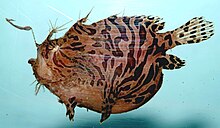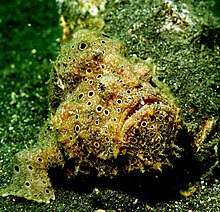|
Antennarioidei
Antennarioidei is a suborder of marine ray-finned fishes belonging to the order Lophiiformes, the anglerfishes. TaxonomyAntennarioidei was first proposed as a taxonomic grouping in 1912 by the English ichthyologist Charles Tate Regan.[1] The 5th edition of Fishes of the World classifies this taxon as one of the five suborders in the order Lophiiformes. It and the suborders Chaunacoidei, Ogocephaloidei, and Ceratioidei, are more derived than their basal sister group the Lophioidei.[2] In some phylogenies the suborder Antennarioidei is the most basal of the Lophiiformes suborders other than Lophioidei.[3] The relationships of the suborders within Lophiiformes as set out in Pietsch and Grobecker's 1987 Frogfishes of the world: systematics, zoogeography, and behavioral ecology is shown below.[3]
  EtymologyAntennarioidei is derived from Antennarius, the type genus of the family Antennaridae. Antennarius suffixes -ius to antenna, an allusion to first dorsal spine being adapted into a tentacle on the snout used as a lure to attract prey.[4] FamiliesAntennarioidei contains the following families and these are related as set out in the cladogram below:[2][5][3]
CharacteristicsAntennarioidei fishes are characterised by the first dorsal fin being made up of three separate spines on the head, the first being the illicium with the second sometimes being short, although this spine is not everr embedded within the skin. The pterygiophores of the first dorsal spine and the third dorsal spine have highly compressed dorsal expansions. The interhyal has a central backwards directed process that touches the preoperculum.[2] DistributionAntennarioidei fishes are found in the tropical and subtropical oceans of the world, although this applies only to the Antennaridae, the other three families being confined to the seas around Indonesia, New Guinea and Australia.[2] References
|
||||||||||||||||||||||||||||||||||||||||||||||||||||||||||||||||||
Portal di Ensiklopedia Dunia
